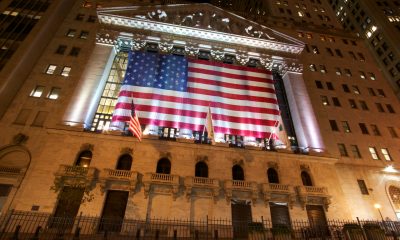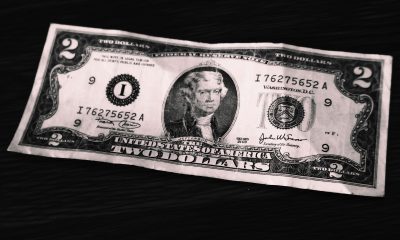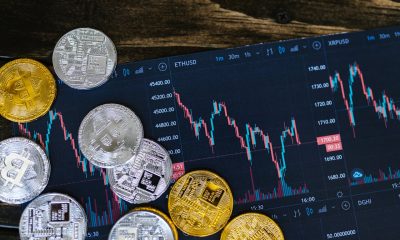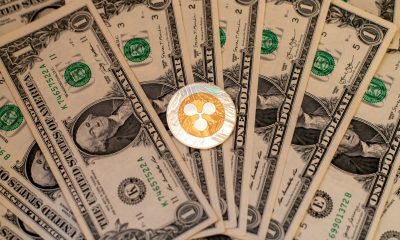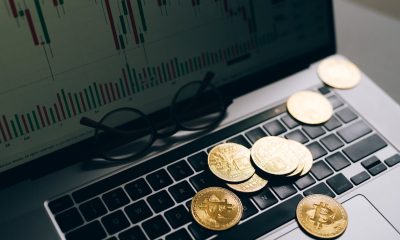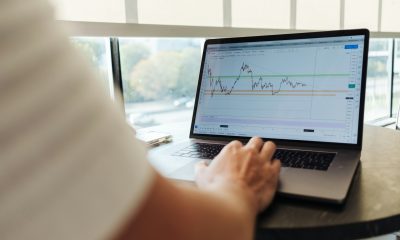Business
America’s Debt Spiral: A $67 Trillion Reckoning Looms by 2035
U.S. debt is soaring, with a 123% debt-to-GDP ratio projected to hit 140% by 2029. Deficits, interest costs, and shrinking buyers for Treasuries threaten solvency. The Fed’s ability to control inflation through bond purchases is weakening. Without major spending reforms, especially to entitlements, the U.S. risks a debt spiral, inflation surge, and bond market chaos.

The US debt-to-GDP ratio is currently at 123% and is projected to reach 140% by 2029. Annual deficits now equal 6.4% of GDP, and the Congressional Budget Office forecasts that the deficit will rise to 9% of GDP, or $2.7 trillion, by 2035. The interest payments on US debt alone account for approximately 3% of the country’s GDP. Even if the primary deficit were eliminated, the debt-to-GDP ratio would not fall unless the underlying economic growth exceeded 3%. However, this is highly unlikely, as both the labor force and productivity are shrinking, with productivity down 1.5% in the first quarter. Achieving consistent 3% growth is therefore impossible.
This year alone, the deficit will add an amount equivalent to 40% of all federal revenue to the national debt. For fiscal year 2025, the deficit already stands at $1.36 trillion, with four months remaining in the year. This figure is 14% higher than last year, and debt financing is expected to run above $1.2 trillion for the fiscal year, totaling $776 billion over the first eight months. Our debt now equals 740% of federal revenue. By 2035, the national debt is expected to reach $67 trillion. It took the United States 250 years to accumulate the first $37 trillion of national debt, and we are now on track to add another $30 trillion in the coming decade.
Who is Going to Buy All these Treasuries?
Several factors have contributed to the shifting landscape of Treasury buyers. The Federal Reserve, for example, is no longer a consistent buyer of bonds; instead, it is actively shrinking its balance sheet. To date, the Fed has sold off $2.3 trillion worth of assets, primarily Treasury securities. Meanwhile, foreign central banks have begun to back away from purchasing US Treasuries. Recent sanctions and the confiscation of foreign assets have heightened concerns about the safety of parking reserves in US dollars.
In addition, the ongoing tariff disputes have created chaos that has, in turn, reduced international capital flows. With diminished global trade, there are fewer trade surpluses, which means fewer dollars are available to be invested in US Treasuries. Compounding the issue, the recent struggle with extremely high inflation has caused investors to worry about the value of the dollar, which underpins the attractiveness of US Treasuries.
Solvency concerns are also mounting as the US continues to run persistent and protracted deficits of $2 trillion annually. This staggering amount of red ink is occurring during times of relative peace and economic prosperity, raising important questions about what might happen during a recession or war. While some Pollyannas argue that the Federal Reserve could always intervene and replace free market demand for Treasuries, the reality is that inflation has now become a significant and potentially insurmountable obstacle.
Debt: The Fed Cannot Easily Save the US Anymore
Some people claim that since the Fed has a printing press, there will always be ample bids for US debt. And, it can print all the credit it wants without creating inflation…just like it did post the GFC. But there are major macroeconomic differences between today and 2007
During and after the Great Recession (from 2007 thru 2014), the Fed printed $4.5 trillion. But such debt monetization back then entailed the buying and removing of distressed bank assets (mortgage-backed securities and real estate-related debt) and then holding them at the Fed. Therefore, the Fed’s money printing mostly led to asset price inflation, as bond yields fell and risk assets increased. However, the Fed credit, for the most part, never made it to Main Street; it remained on Wall Street, and Consumer Price Inflation remained quiescent
However, if the Fed were forced to once again monetize trillions of dollars of debt today—either due to a recession or rising bond yields — the inflation would most likely not remain confined to Wall Street. This is because annual deficits are already $2 trillion, compared to $900 billion before the Global Financial Crisis (GFC). And, during the next recession, annual deficits are expected to rise to between $4 and $6 trillion due to the automatic economic stabilizers triggered by a rising unemployment rate. Speaking of a rising unemployment rate and a fracturing labor market, US continued jobless claims last week came in at 1.95 million. That figure is the highest since November 2021.
In the next recession, the money (credit) printed by the Fed and given to banks would in turn be used to purchase a tsunami of government debt instead of mortgage bonds–using private banks as a conduit to monetize trillions of dollars in Treasury debt. This means the money would find its way to Main Street, rather than remaining on Wall Street, causing broader monetary aggregates to increase. This, in turn, will send inflation rates soaring and put upward pressure on bond yields.
This is what occurred during Helicopter Money 1.0 (the post-COVID money printing). Helicopter money 2.0 promises to make inflation much worse. Mortgage bonds, corporate debt, student loans, and auto loans are all tied to the Benchmark lending rate. The Fed “PUT” will not work if longer term bond yields rise as the Fed Funds Rate gets lowered.
Possible Solutions
- The US should avoid raising the debt ceiling by $5 trillion without first ensuring entitlement reforms are made to Social Security, Medicare, and Medicaid.
- In the current Big Beautiful Bill, which was passed by the House and is being debated in the Senate, spending cuts amount to just $160 billion per annum and are–for the most part–back-end loaded. What is needed instead is a reduction in spending of $1 trillion per annum just to keep the debt-to-GDP ratio stable.
- The so-called 3rd rail of politics must be touched. Solutions could include raising the retirement age of Social Security for those who are not currently in the program and are not scheduled to receive benefits for at least a decade. Also, income caps for contributions can be raised. Means testing for Medicaid recipients should also be considered. Those who are of working age and in good health should not be eligible for Medicaid.
We must do everything feasible to reduce our debt-to-GDP ratio while the bond market remains functional. Increasing the debt ceiling by $5 trillion without curbing deficits invites chaos into the bond market. We also must address the debt debacles before the next recession arrives. The US has averaged a recession every 6.4 years since WWII; and recessions always cause deficits to explode higher. The risk of a debt death spiral is very real, where the central bank is forced to usurp the free market for bonds by consistently printing trillions of dollars per annum to prevent bond yields from spiking inexorably. However, that very process could create runaway inflation, which in turn will push bond yields relentlessly higher regardless of the Fed’s efforts.
Tremors in the bond market are evident right now. The falling dollar, as bond yields rise, is evidence that the danger is very real. It is surely a sign that faith in our currency and our sovereign debt market is failing. God willing, we will be spared from the massive quake.
Chaos in the credit markets will be what pops the real estate, business debt, and equity market bubbles. It is the one factor that Pento Portfolio Strategies monitors most closely for our signal when to take the necessary steps to both protect and profit from the grand reconciliation of asset prices. It even supersedes geopolitical strife, which is front and center today. Investors need not panic over every headline about bombs, or each threat of tariffs. Nor get swayed by every garrulous word that proceeds from an FOMC mouth. That is why having a robust model is crucial for investors’ success.
__
(Featured image by Gabriel Meinert via Unsplash)
DISCLAIMER: This article was written by a third party contributor and does not reflect the opinion of Born2Invest, its management, staff or its associates. Please review our disclaimer for more information.
This article may include forward-looking statements. These forward-looking statements generally are identified by the words “believe,” “project,” “estimate,” “become,” “plan,” “will,” and similar expressions. These forward-looking statements involve known and unknown risks as well as uncertainties, including those discussed in the following cautionary statements and elsewhere in this article and on this site. Although the Company may believe that its expectations are based on reasonable assumptions, the actual results that the Company may achieve may differ materially from any forward-looking statements, which reflect the opinions of the management of the Company only as of the date hereof. Additionally, please make sure to read these important disclosures.

-

 Africa2 weeks ago
Africa2 weeks agoMorocco Confirms Massive Egyptian PVC Dumping, Moves to Impose Final Tariffs
-

 Crowdfunding2 days ago
Crowdfunding2 days agoFlower Burger Launches Crowdfunding to Fuel Growth in Booming Plant-Based Market
-

 Biotech1 week ago
Biotech1 week agoNurExone’s Exosome Platform Gains Global Spotlight with Dual 2025 Award Nominations
-

 Business7 days ago
Business7 days agoThe TopRanked.io Weekly Digest: What’s Hot in Affiliate Marketing [PureVPN Affiliate Program Review]
